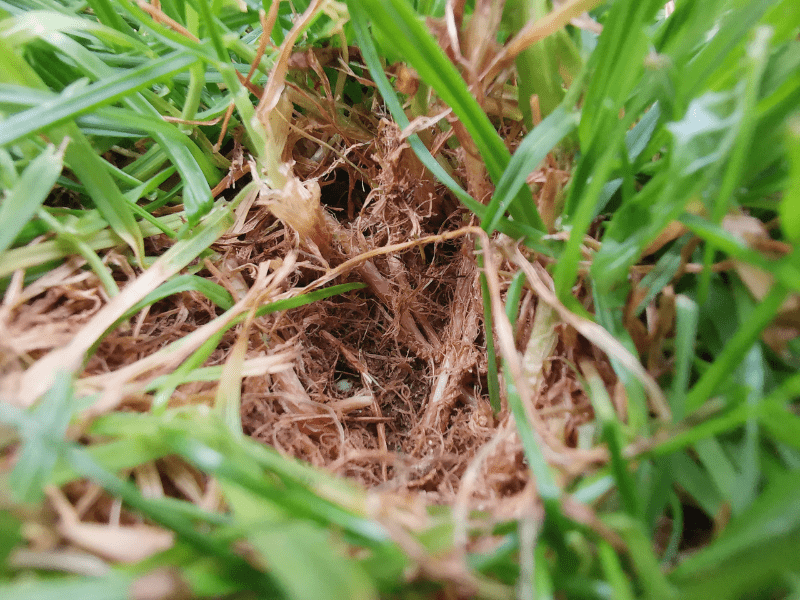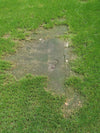
All About Lawn Thatch
Keeping your lawn in top form involves some simple but consistent care practices. The removal of thatch is an important part of good lawn maintenance. In this blog, we look at what thatch is, how to remove it, and how to prevent it.
What is thatch?
Thatch is a build up of organic matter that accumulates around the base of the grass plants. Thatch is made up of a mix of dead grass roots and stems, clippings, leaves, and other debris that have found their way into your lawn, forming a dense fibrous layer just above the soil.
Is lawn thatch good or bad?
Thatch is a natural occurrence in most lawns, but its effects on the health of your grass depend on how it is managed. A small amount of thatch is normal and quite healthy, it can cushion and protect the crown of the grass, and shield the soil from the elements. But when left to build up, thatch can be detrimental to your lawn.
A build up of thatch will prevent air, water, and nutrients from reaching the roots of your grass, as well as being the perfect breeding ground for moss and lawn diseases. If left to accumulate thatch will dry the soil. A dry soil will force the grass to grow roots into the thatch, making your lawn spongy and irregular.
Will lawn thatch go away on its own?
In ideal conditions, thatch is decomposed by naturally occuring bacteria and fungi which break down the layers, maintaining a healthy balance for your lawn. However, due to natural components in the grass that slow down decomposition, your lawn often grows quicker than the old grasses can naturally be broken down by bacteria. So, over time, excess thatch builds up in your lawn and external intervention is needed to keep your grass healthy.
How to prevent thatch build up
Little and often is the way to go with most care processes if you are looking to keep your lawn as healthy as possible through the year. There are things we can do that will not only prevent thatch build up, but also contribute to the overall growth and health of your grass.
Aerate Your Lawn
Aerating is a process that creates small hollow channels that allow air and water to move more efficiently through the soil. Better air and water circulation in the soil encourages beneficial microbial activity that, in turn, will break down thatch at a faster rate. Aeration is also ideal for the more severe cases of thatch build up, as it helps break through subsurface thatch to allow water and nutrients to reach grass roots.
Aeration can be done by spiking the lawn with a garden fork, or by using a hollow tin aerator, which extracts cores of soil and is more effective on heavily compacted soils.
Fertilize Correctly Through the Year
Feeding your lawn is important in maintaining its health and performance over time, you can read more about the benefits in this blog. But it is essential that you apply the correct feed, in the correct amount, at the right time of the year.
As we have mentioned above, thatch build up is the result of an imbalance between grass growth and dead matter decomposition. By fertilising incorrectly or excessively, you may be inadvertently increasing thatch build-up and weakening your lawn. Following a feeding plan like the So & Mo Performance Liquid Lawn Feed will help you deliver the right balance of nutrients to your grass, keeping your turf in top form through the year.
How to get rid of thatch in your lawn
Scarify, scarify, and scarify some more. Scarifying is the name given to the process of removing organic matter from around the base of the grass. It is the easiest and most effective way to get rid of thatch layers in your lawn. Scarification can be done by raking the lawn or, if the build up is severe, by using a scarifying machine.
The first time you scarify, you may be surprised by the amount of matter that you’re lifting from the grass, but don’t be scared to be vigorous and take a lot of material out, whether this is with a good old wire rake or a scarifying machine.
When should I dethatch my lawn?
Dethatching puts a fair amount of stress on your lawn, so the best time to scarify is in the growing seasons, when the weather is good enough for the grass plants to recover and to infill the areas where thatch or dead grasses have been removed.
If the thatch build up on your lawn is considerable, removing it may leave your lawn weakened and thinned, so overseeding may be required in the bare areas.
If you would like to learn more about scarifying and taking care of your lawn, make sure to visit our blog and Youtube channel, for tips and advice that will help you maintain your lawn in top condition!Ready to be proud of your garden?
Ensure your lawn never goes hungry with our personalised feeding plan. Delivered through you letterbox exactly when you need it.





